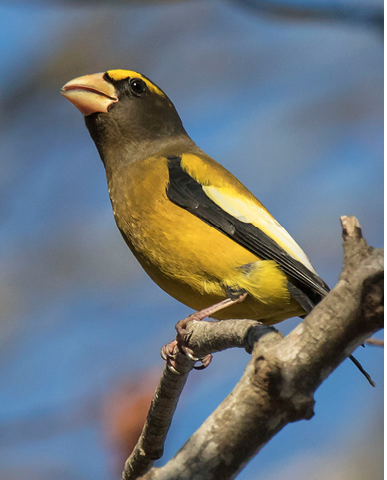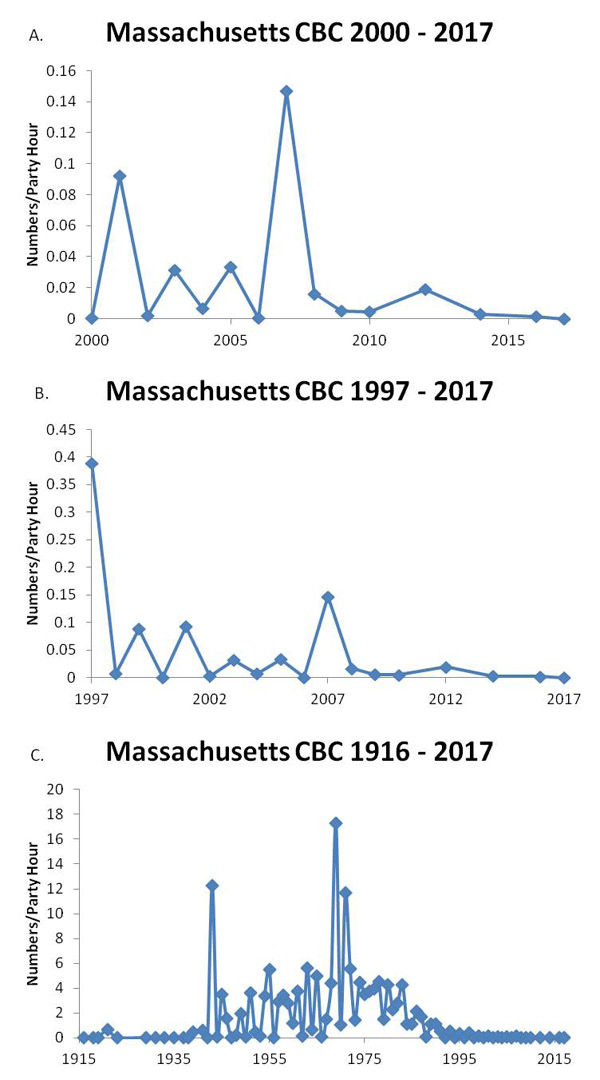Melinda S. LaBranche

Evening Grosbeak. Photograph by Sandy Selesky.
Growing up in Grafton, Massachusetts, we had a huge red maple in our backyard. During winter (perhaps all of them as in my memories, but likely just one) we had day after day of enormous flocks of Evening Grosbeaks (Coccothraustes vespertinus) that seemed to fill that tree. I know we all tried to count them and I recall that I managed to tally at least 100. This is my first memory of counting birds, still a family passion and a lifelong pursuit for me. The winter of 2019 was the first time that I was graced with their presence in Rochester, Massachusetts, from mid-January to May 14. I spent hours avoiding my grading, copyediting, and doing dishes to watch these spectacular birds, numbering 20 to 40 individuals, so uniquely garbed that I thought I was able to distinguish a few individuals from all the rest.
Evening Grosbeaks, large finches with relatively short tails and big honkin' beaks, were described by Forbush (1929) as "Catbird size but stouter" with bill "sparrow-like, but enormous for size of bird, much larger than that of Pine Grosbeak…" Henry Rowe Schoolcraft sent the type specimen to William Cooper of the Lyceum of Natural History of New York, using the Chippewa name Pashcundamo (or Paushkundamo) meaning berry-breaker (Farrand 1992). And Harrison (2001) notes that birdbanders handling Evening Grosbeaks wear gloves or risk blood flow. Having banded several other finch species, although not Evening Grosbeak, I think I'd still be a bit more wary of a woodpecker's bill.
Surprisingly for their bill's seed-crushing size and their reputation for emptying sunflower-seed feeders, Evening Grosbeaks prefer spruce budworms (Choristoneura spp.) and similar grubs, and also feed on seeds from trees, especially maple (Acer sp., Gillihan 2001). They do, however, feed on many seed types and in seed-size experiments they chose larger seeds and ingested more of the seed kernel than smaller-beaked finches (Benkman 1988).
Their range expansion from the Rocky Mountains to the east, beginning in the mid-1800s, is thought to coincide with the planting of boxelders (Acer negundo) as wind blocks and ornamentals. And boxelder's extended retention of seeds may have promoted some birds to forgo migration, leading to the first breeding records in the northeastern United States (Forbush 1929).
Notably, Evening Grosbeaks are more active in morning than in evening, in contrast to their moniker, which stems from accounts by Schoolcraft and later Major Joseph Delafield, both misinterpreted by Cooper (Farrand 1992). Variously stating that they only sing in the evening and that a roosting flock was disturbed in the evening, in 1825 Cooper named the species Evening Grosbeak and gave the specific epithet vespertinus (evening). Despite numerous descriptions of their daytime activities, the evening designation was further amplified in 1903 when the genus Fringilla was replaced with Hesperiphona (Gillihan and Byers 2001), meaning evening cry. In 1982, it was placed into the genus Coccothraustes, leaving only Cooper's original misnomer (Gillihan and Byers 2001).
Evening Grosbeak flocks can't help but attract attention with their colors and constant chatter. Males are conspicuously yellow and black with quizzical yellow supercilliaries (eyebrows). The bright yellow breast and belly contrasts boldly with the black-and-white wings. Females and juveniles are duller than males with brownish yellow bellies and with less boldly contrasting wings (Gillihan and Byers 2001). Evening Grosbeaks' striking sexual and age polymorphism certainly aids in studying their behaviors and distribution.
Reminiscent of the birds at my feeders, Balph and Balph (1976) documented a female-biased sex ratio, on average about four females for every three males. At their location in Logan, Utah, the sex ratio shifted from even more females in winter to a nearly equal sex ratio in spring. But Bekoff and Scott (1989), in Colorado, had sex ratios consistently skewed toward males, on average about three males for every two females averaged over all calendar months. Differential patterns of migration, with females migrating farther than males, may affect local sex ratios, which can be seen in banding records across a wide geographical range (Balph and Balph 1976). Some research suggests that females migrate farther than males due to their smaller body size, making them less tolerant of cold, or due to male aggression at feeding sites (Gillihan and Byers 2001).
Aggression in Evening Grosbeaks, although rare, appears to be mostly within the sexes not between them. In a three-year study, Bekoff and Scott (1989) demonstrated that males were more aggressive than females. Antagonism was mostly intrasexual, more frequent among males than females and correlated with the number of males in a flock. As you might suspect, aggression rates were highest just before the breeding season. Dominance tended to be related to weight and wing length measured at the time of banding, differences that could be maintained in the field (Bekoff and Scott 1989). Despite low levels of aggression between the sexes, males are dominant to females, perhaps also as a function of body size. Interestingly, social dominance may be further complicated by individual recognition in small flocks where intersexual relationships between individuals are maintained through a season (Balph et al 1979).
Another behavioral difference between the sexes occurs in response to predators. Balph (1977) noted that females were more likely than males to freeze in place upon a "fright." She suggested that the vulnerability of males due to their bright colors selected for finding cover. Males fleeing from predation also may distract predators from the immobile females.
This chubby bird with its flagrant colors is an irruptive species that wanders in large flocks usually in response to low food supplies (Gillihan and Byers 2001). So I wasn't surprised that I hadn't many encounters with them for more than 40 years. But upon further reading, I learned that Evening Grosbeaks appear to have been declining across their range for several decades (Bonter and Harvey 2008, Ralston et al. 2015). I decided to look at the Massachusetts Christmas Bird Count (CBC) data (Pardieck 2019) for myself and was relieved to see that in this century the numbers of observations varied year to year as expected but didn't appear to be declining (Figure 1A). For some reason I decided to rebuild my graph with an even 20 years and that's where I was shocked (Figure 1B). The decline at the end of the 1990s was dramatic, showing that the 18 years in my first look were only 25% of 1998–1999. As I looked at the entire CBC data set (Figure 1C) the pattern was clear, counts per party hour in the 50s to 80s were about 4, with peaks of 11 and 17 during my years in Grafton, compared to the twenty-first century average of 0.024 counts per party hour.

Fig. 1. Christmas Bird Count data for Evening Grosbeaks for a) 2000-2017, b) 1997-2017, c) entire historical data 1900-2017.
What does this decline signify? Given the grosbeak's nineteenth century range expansion, prior to the first reports of Evening Grosbeaks in the CBC, this may simply indicate a natural range reversal (Ralston et al. 2015). Alternatively, other issues may be at play including forest management practices, urban expansion, or changes in their food availability. The State of the Birds 2014 Report lists a 32% drop in eastern forest-obligate species since 2009 and the report lists development and changes in forests—especially fire and exotic plant species—as the major threats (NABCI 2014). Using Project FeederWatch data, Bonter and Harvey (2008) indicate that the decline in both abundance and range could be related to recent changes in management of Canada's boreal forests, particularly increased logging. They add that disease and spruce budworm control using pesticides in the United States and Canada also may be contributing factors.
In another evaluation of the plummet in grosbeak numbers, Ralston et al. (2015) documented significant declines in obligate and associated spruce-fir species. Among the species that are not currently listed as of conservation concern, Evening Grosbeak and Canada (Gray) Jay (Perisoreus canadensis) demonstrated severe declines. Indicator species for these northern forests—such as two listed as threatened, Bicknell's Thrush (Catharus bicknelli) and Olive-sided Flycatcher (Contopus cooperi)—are in significant decline. Ralston et al. suggest habitat degradation as a cause for all of these declines.
For my part, I surmise that range contraction and forest changes such as logging practices and pest control are contributing to the disappearing grosbeaks. I agree with the authors noted that the declines are complex and no one factor is responsible throughout the bird's range.
Back at home in Rochester, I'm hoping that these beautiful jewels of my childhood will return this winter to decorate my feeders and trees. If not, maybe my Pine Siskins will zzzzzzip back after a three-year hiatus.
References
- Balph, M. H. 1977. Sex differences in alarm responses of wintering Evening Grosbeaks. Wilson Bulletin 89 (2): 325–327.
- Balph, M. H. and D. F. Balph. 1976. Some factors influencing observed sex ratios in a population of Evening Grosbeaks. Bird-Banding 47 (4): 340–344.
- Balph, M. H., D. F. Balph, and H. C. Romesburg. 1979. Social status signaling in winter flocking birds: an examination of a current hypothesis. Auk 96: 78–93.
- Bekoff, M. and A. C. Scott. 1989. Aggression, dominance, and social organization in Evening Grosbeaks. Ethology 83 (3): 177–194.
- Benkman, C. W. 1988. Seed handling ability, bill structure, and the cost of specialization for crossbills. Auk 105 (4): 715-719.
- Bonter, D. N. and M. G. Harvey. 2008. Winter survey data reveal rangewide decline in Evening Grosbeak populations. Condor 110 (2): 376–381.
- Farrand, J. Jr. 1992. How the Evening Grosbeak got its name. American Birds 46 (5): 1184–1186.
- Forbush, E. H. 1929. Birds of Massachusetts and Other New England States. Part III: Land Birds from Sparrows to Thrushes. Norwood, MA: Norwood Press for the Massachusetts Department of Agriculture.
- Gillihan, S. W. and B. E. Byers. 2001. Evening Grosbeak (Coccothraustes vespertinus), version 2.0 in The Birds of North America Online (A. F. Poole and F. B. Gill, eds). Ithaca: Cornell Lab of Ornithology: https://doi.org/10.2173/bna.599 [accessed September 19, 2019]
- Harrison, G. 2001. Charming yellow gluttons. Birder's World. December 44–47.
- National Audubon Society. 2019. The Christmas Bird Count Historical Results [Online]. Available from: http://www.christmasbirdcount.org [accessed July 28, 2019]
- North American Bird Conservation Initiative, U.S. Committee. 2014. The State of the Birds 2014 Report. Washington, D.C.: United States Department of the Interior. Available from:
- Pardieck, K.L., D.J. Ziolkowski Jr., M. Lutmerding, V. Aponte and M-A.R. Hudson. 2019. North American Breeding Bird Survey Dataset 1966 - 2018, version 2018.0. United States Geological Survey, Patuxent Wildlife Research Center. Available from: https://doi.org/10.5066/P9HE8XYJ.
- Ralston, J., D. I. King, W. V. DeLuca, G. J. Niemi, M. J. Glennon, J. C. Scarl, J. D. Lambert. 2015. Analysis of combined data sets yields trend estimates for vulnerable spruce-fir birds in northern United States. Biological Conservation 187: 270–278.
Melinda S. (Mindy) LaBranche is an adjunct professor of biology at Bridgewater State University and Massasoit Community College where she teaches environmental biology, general biology, ecology, and sometimes ornithology. She also is a copy editor for Bird Observer and lives with her husband and large menagerie in Rochester, Massachusetts.